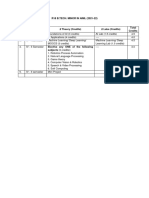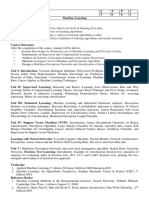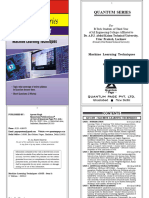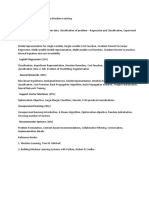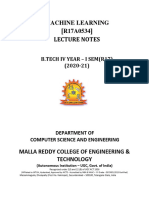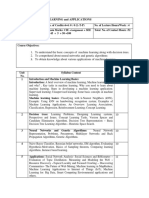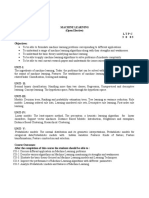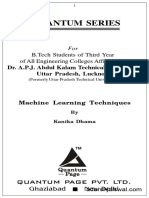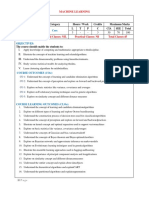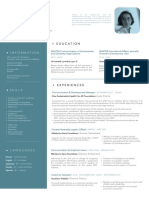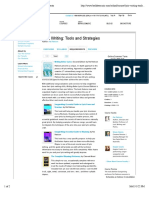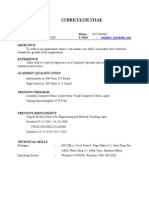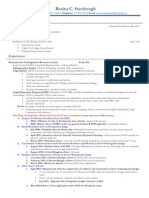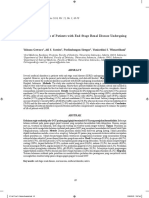III B.Tech.
L T P C
MACHINE LEARNING
II Semester 3 0 0 3
COURSE OBJECTIVES
1. To Understand Human learning aspects.
2. To introduce students to the basic concepts and techniques of Machine Learning.
3. To understand primitives in learning process by computer.
4. To understand nature of problems solved with Machine Learning.
COURSE OUTCOMES
Student will be able to
1. Model the learning primitives.
2. Understand a wide variety of learning algorithms.
3. Understand how to apply a variety of learning algorithms to data.
4. Understand how to perform evaluation of learning algorithms and model selection.
5. Capable of performing experiments in Machine Learning using real-world data
6. Capable of confidently applying common Machine Learning algorithms in practice and
implementing their own to tackle real world problems in the domain of Data Mining,
Information Retrieval, Computer vision, Linguistics and Bioinformatics.
UNIT I: INTRODUCTION TO MACHINE LEARNING
Introduction to machine learning: Concept Learning and the General to Specific Ordering:
Concept learning task, concept learning as search, Find-S: finding a Maximally Specific
hypothesis, Version Spaces and the Candidate-Elimination algorithm, remarks on Version
Spaces and Candidate-Elimination and inductive bias.
UNIT II: DECISION TREE LEARNING
Decision Tree representation, appropriate problems for Decision Tree learning, hypothesis
space search in Decision Tree learning, inductive bias in Decision Tree learning and issues in
Decision Tree learning.
UNIT III: EVALUATING HYPOTHESES
Estimating hypothesis accuracy, basics of sampling theory, general approach for deriving
confidence intervals, difference in error of two hypotheses and comparing Learning
algorithms.
UNIT IV: BAYESIAN LEARNING
Bayes theorem and concept learning, maximum likelihood and least squared error
hypotheses, maximum likelihood hypotheses for predicting probabilities, minimum
description length principle, Bayes optimal classier, Gibbs algorithm, Naive Bayes classier,
Bayesian belief networks and EM algorithm.
UNIT V: COMPUTATIONAL LEARNING THEORY
Introduction, probably learning an approximately correct hypothesis, sample complexity for
finite hypothesis spaces, and sample complexity for infinite hypothesis spaces and mistake
bound model of learning.
UNIT VI: INSTANCE BASED LEARNING
Introduction, k-Nearest Neighbor learning, locally weighted regression, radial basis
functions, Case Based Reasoning and remarks on Lazy and Eager learning.
Genetic Algorithms: Introduction, hypothesis space search, Genetic programming and
models of evolution and learning. Learning Resources:
TEXT BOOKS
1. Tom M. Mitchell, Machine Learning, Mc Graw Hill Publishing
2. EthemAlpaydin, “Introduction to Machine Learning”, MIT Press, Prentice Hall of India,
3rd Edition2014.
REFERENCE BOOKS
1. CharuC.Aggarwal,“DataClassificationAlgorithmsandApplications”,CRCPress,2014.
2. Charu C. Aggarwal, “DATA CLUSTERING Algorithms and Applications”, CRC Press,
2014.
3. Kevin P. Murphy ”Machine Learning: A Probabilistic Perspective”, The MIT Press, 2012
�WEB LINKS
1. http://searchenterpriseai.techtarget.com/definition/machine-learning-ML .
2. http://www.geeksforgeeks.org/machine-learning/.
3. http://www.tutorialspoint.com/mahout/mahout.machine-learning.htm.



